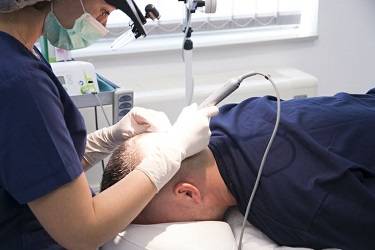For men, middle age and hair loss go hand in hand.
As soon as you hit that 40’s mark, the tell tale signs of thinning hair start manifesting themselves.
Hairline is the first to disappear, followed by appearance of bald patches.
Many of you resort to the use of hair growth shampoos, gels and other products being marketed for this purpose, only to end up considering the option of hair transplant as this is the only procedure that promises lasting results.
What causes baldness?
So, what causes baldness? Androgenic alopecia (AGA) is the term given to male pattern baldness. The factors that contribute to it are as follows.
- Reduction in male sex hormone testosterone is the main factor that leads to pattern baldness. 5-α-reductase is the enzyme responsible for the conversion of testosterone to dihydrotestosterone (DHT).
DHT seeps into the hair follicles, impeding the blood flow to the follicles and depriving them of the nutrients essential for hair growth. Hair loss is the inevitable result of this process. - Genetics is another factor that plays a pivotal role in the emergence of pattern baldness. Androgenic alopecia is a Y-linked disorder, that is, the gene for it is passed from father to son. Males with family history of pattern baldness are 2.5 times more likely to develop it.
- Aging can also lead to baldness. Reduction in the amount of testosterone and Follicle Stimulating Hormone (FSH) and increase in the amount of Sex Hormone Binding Globulin (SHBG) with age can lead to baldness in males.
- Metabolic disorders related with obesity in males can also trigger pattern baldness.
How to treat baldness?
Most of the formulations sold for alopecia contain DHT blockers that inhibit DHT and prevent it from exerting its effects on the hair follicles. DHT blockers are available in the form of capsules, sprays, topical gels, shampoos, conditioners and other preparations.
 A man is donating his hair – doctor is harvesting the donor area.
A man is donating his hair – doctor is harvesting the donor area.5-α-reductase inhibitors are also available for the same purpose. They inhibit the enzyme 5-α-reductase and prevent the formation of DHT but they are now becoming obsolete on account of the adverse affects caused by them. They can cause impotence, decreased libido, anxiety and depression amongst males.
Hair transplantation is the contemporary technique available for long-term solution of hair loss problem. It is becoming rapidly popular around the globe and more and more people are getting their receding hairlines fixed with this technique.
Hair transplantation: the ultimate solution
Many of you would have envied Mel Gibson, the Hollywood heartthrob, for his luscious hair. Still think Mother Nature had something to do with it? It was hair transplant that worked its magic for him.
Sourav Ganguly, the cricketer; Wayne Rooney, the football player; James Nesbitt, the actor; Declan Donnelly, the TV presenter; Louis Walsh, the X-factor judge; Gordon Ramsay, the TV chef; Rob Brydon, the actor; David Beckham, the football player; Shane Warne, the former cricket player; Elton John, the singer and Dennis Miller, the comedian are some of the other celebrities who made use of hair transplant techniques to transform their looks.
It’s not only celebrities who can get their hair transplanted; you can get it too. Technological advances have resulted into two types of techniques being used for hair transplantation.
- Follicular unit extraction (FUE)
- Follicular unit transplantation (FUT)
FOLLICLAR UNIT TRANSPLANTATION (FUT)
This technique involves the simple principle of removal of hair from the back of the scalp in the form of strips to be transplanted onto the bald patches. The excised hair strips are carefully dissected into individual follicular units that are grafted onto the recipient sites.
Advantages offered by this technique include:
- Cost-effectiveness
- Less time consuming
- Greater number of hair transplantation per unit
The disadvantages are:
- The donor sites are disfigured by the formation of linear scars that are quite evident, unless covered by long hair.
- Donor site wound complications are common.
- Graft rejection might occur.
- Painful method.
FOLLICULAR UNIT EXTRACTION (FUE)
In this method, the individual hair follicles are extracted with the help of fine bored needles. The success rate of the method depends, to a large part, on the internal diameter of the extraction needles; the finer the needle, the better is the success rate.
After extraction the individual follicular units are harvested onto the balding areas of the scalp. After a few weeks, the grafted hair follicles adopt the natural growth patterns.
The expertise of the surgeon plays a major role in this procedure.
The pros of this method are:
- Formation of minute, nearly invisible scar tissue.
- Selective transplantation of hair units that give the maximum yield.
- A virtually painless method.
The cons of FUE are:
- A time consuming method.
- Laborious procedure.
- Greater number of sessions required for achieving the targeted goals, makes this method more expensive as compared to FUT.
The important thing to understand about hair transplant is the recurrence of hair loss problem few years after the transplant. It is not the transplanted hairs that start falling off; those are the original, non-transplanted hair.
This has led to the common misconception among the masses about hair transplantation being of no good.
It is also imperative to understand that none of the marketed products can reconstruct your natural hair; these myths have to be busted. Don’t succumb to the promise of natural looking hair that these products offer.
The efficacy and productive results have given the FUE technique an obvious edge over the FUT method. Consultation with a competent hair transplant surgeon can help you decide upon the course to be taken. Remember, regaining your hair is difficult, it is not impossible.










































Man, FUT is outdated indeed. Most modern clinics use FUE method and it is safer as well.
The surgeon and other staff were informative, made sure I understood every step, and made me comfortable. The procedure was performed with professionalism and continued concern for my comfort. I will return here, if I decide on other procedure. The staff are welcoming and informative.
Here is some benefit of FUT hair transplant:
• This procedure is not much costly.
• Less time consuming.
• Greater number of hair transplantation can be implants per unit.